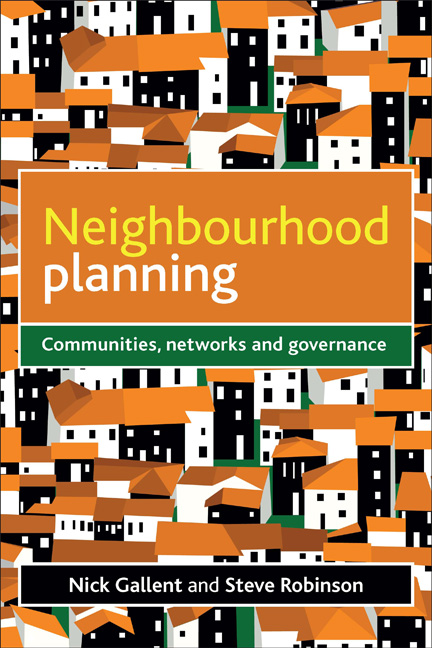Book contents
- Frontmatter
- Dedication
- Contents
- List of figures, images and table
- Abbreviations
- Acknowledgements
- Authors’ note
- Part One Democracy, planning and localism
- Part Two Capacity building and community-based planning
- Part Three The interface with policy actors
- Part Four Neighbourhood planning, leadership and democratic renewal
- References
- Index
nine - Connectivity at the policy–community interface
Published online by Cambridge University Press: 07 September 2022
- Frontmatter
- Dedication
- Contents
- List of figures, images and table
- Abbreviations
- Acknowledgements
- Authors’ note
- Part One Democracy, planning and localism
- Part Two Capacity building and community-based planning
- Part Three The interface with policy actors
- Part Four Neighbourhood planning, leadership and democratic renewal
- References
- Index
Summary
In the last three chapters, we explored, through a review of past studies and also through an initial presentation of local case study material, some of the practical building blocks for collaborative action: the networks that provide the context for consensus building and which give community groups the capacity to work with others in the pursuit of shared outcomes. In Chapter Six, we introduced some of the ways in which dialogue between network members may be problematic, noting a divide between policy and interest communities, which may be expressed in poor communication and a lack of trust, reciprocity and authentic dialogue, and ultimately in coercive power-play rather than in consensual action. This issue provides a key focus for the next series of chapters.
If the possibility of ‘consensual power’ is accepted, then finding ways to bridge the cultures of policy and community interest seems a worthwhile endeavour. The idea of ‘bridging’ or ‘brokering’ between different subsections of a potential more expansive network (bringing together community and policy actors) was introduced within the broader discussion of network mechanics and structure, again in Chapter Six. ‘Bridging’ has a particular meaning in social network analysis, and is used to refer to sometimes ‘weak’, or seemingly incidental ties that can be used to span ‘structural holes’, or gaps in what might otherwise be a common network. The concept of ‘bridging’, taken forward in this analysis, refers to the use of an intermediary or broker who provides a communication link between the private realm of community action and the public realm of traditional policy making – divided by a clear gap – and who has a centrality in a network owing to their occupation of a strategic position between network subgroups. Bridging is viewed both as a general feature of network structure, with intermediaries stepping in to work with community and policy actors, and as a means of dealing with community-based plans: that is, ‘bridging’ to local plans rather than seeking the direct absorption of community plans into formal policy making. The treatment of community-based plans is given special attention in this discussion, as it is this treatment that expresses different ideas of how best to draw communities into broader democratic processes.
- Type
- Chapter
- Information
- Neighbourhood PlanningCommunities, Networks and Governance, pp. 109 - 122Publisher: Bristol University PressPrint publication year: 2012



